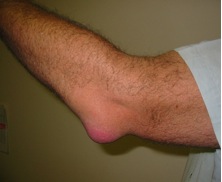Olecranon bursitis

A bursa is a fluid-filled sac between the skin and bones on the back of the elbow. Usually you will not see the olecranon bursa; bursitis is a condition when it becomes inflamed. The bursa may also become infected. It can cause pain and can restrict motion of the elbow. The primary symptom is swelling but may also feel pain when the elbow is touched or moved. Sometimes swelling can be severe enough to restrict motion of the elbow. Redness of the skin around the elbow, fever and chills are the signs of an infection in the bursa.
Why have I got Olecranon bursitis?
Elbow bursitis can be caused by a sharp blow or a repeated injury to the elbow, prolonged pressure such as leaning on a table-top for long periods of time. For example 'student's elbow' occurs in people who study with their elbows leaning on a desk. Other names include 'miner's elbow', 'plumber's elbow', etc, when the job involves crawling a lot using elbows. Less commonly it can be caused by infection or by medical conditions, such as arthritis or gout.
What is the non operative treatment?
Usually it will settle with simple measures. If the bursitis is not caused by an infection it may be treated with ice, anti-inflammatory tablets such as ibuprofen (unless contraindicated) and sometimes a compressive bandage to reduce the swelling.
If the bursitis is caused by an infection antibiotics are prescribed and fluid may be removed from the bursa with a syringe and needle. For bursitis related to trauma a steroid may be injected into the bursa after the fluid is drained. If you protect the elbow from excessive friction and rubbing it may prevent further bouts of bursitis. This may mean using elbow pads if you need to lean on your elbows whilst working.
What are the surgical options?
Surgery may be needed for infections which do not settle with antibiotic therapy or for pain and swelling that are not relieved by non-operative measures. The bursa is removed with keyhole surgery or through a 6cm incision along the back of the elbow. Keyhole surgery has the advantage of a quicker recovery and avoids the risk of wound problems which exist with a large incision. It is dressed with a bandage to stop the cavity, which is created after the bursa is shelled out, from filling with fluid. The bursa will usually grow back after surgery, because the skin needs to slide over the olecranon smoothly. The bursa that reforms after the operation will not be thick and painful, but similar to a normal bursa.
What is the post operative recovery?
This is a day case procedure. The elbow should be rested as the wound can start to weep over the point of the elbow and excessive movement can cause bleeding into the cavity. The elbow is therefore placed in a bulky bandage which stays on for 2 weeks. The elbow is mobilised and used as able within the confines of the bandage during this time.
When can I return to work and driving?
Driving can be resumed as soon as it is comfortable which is sometimes just a few days. Office works as soon as you feel able. Manual workers will typically need 3 weeks off work, or return to light duties only.



